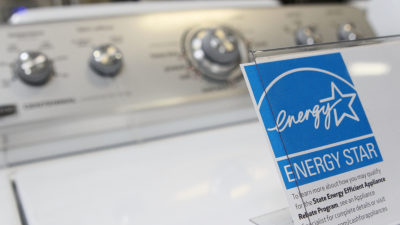Consider Haiku, a line of sleek, quiet, and smart ceiling fans. Haiku fans can be equipped with temperature and humidity sensors, as well as LED lights, and they can be controlled by a mobile phone, a Nest thermostat, Amazon’s Alexa, or a Jawbone fitness tracker, which will turn off a bedroom fan once a user falls asleep. Not incidentally, Haiku fans are energy efficient — they capture the top nine spots among 423 ceiling fans certified by Energy Star, the federal government’s popular energy efficiency program.
The Trump administration wants to shut down Energy Star, a 25-year-old program run by the U.S. Environmental Protection Agency, as part of its plan to slash the EPA budget. While the White House was expected to try to rein in EPA — the agency was a Trump target during the presidential campaign — the move to eliminate Energy Star is surprising. About 16,000 companies and organizations, including Big Ass Solutions, Haiku’s parent company, have chosen to participate. Last week, more than 1,000 participants — including major manufacturers such as United Technologies, real estate firms such as CBRE Group and retailers such as Staples — asked Congress to protect the program.
“We applaud Energy Star,” says Jon Bostock, the chief financial officer of Big Ass Solutions and a former manager in General Electric’s appliance unit, who knows the program well. “It has pushed brands. It’s driven a ton of innovation. It’s provided value for the customer.”
Based in Lexington, Kentucky, fast-growing Big Ass is the kind of company Trump professes to like. It manufactures industrial, commercial, and residential fans, mostly in the United States, where it employs nearly 900 people. Because Energy Star is voluntary — no company is required to participate, and no consumer is obligated to buy certified products — Bostock says he can’t see why the government would want to eliminate it.
He’s not alone. “A lot of people have been wondering about that,” says Lowell Ungar, senior policy advisor at the American Council for an Energy-Efficient Economy, a Washington-based nonprofit.
‘Why mess with a program that is helping consumers, saving energy, improving air quality, and creating jobs?’
“This is a program that’s working,” Ungar adds. “People, almost universally, know what it is. They trust the brand. The retailers love it because it enables them to market better products. Why mess with a program than is helping consumers, saving energy, improving air quality, and creating jobs?”
Says Kateri Callahan, president of the Alliance to Save Energy, which is lobbying to save Energy Star: “It’s inexplicable.”
Launched in 1992 under President George H.W. Bush, Energy Star sets efficiency standards in more than 70 product categories, including appliances, electronics, and heating, cooling, and lighting equipment. Those standards change over time; the agency strives to set them at a level at which the top 25 percent of products, in terms of energy efficiency, qualify for the blue-and-white Energy Star label. It also certifies commercial office buildings and homes. In its most recent annual report, the EPA says Energy Star, which costs less than $60 million a year to operate, saved consumers and businesses $31 billion a year on their energy bills. Those numbers are unavoidably fuzzy because it’s hard to know whether refrigerators or laptop computers would have become more efficient in the absence of Energy Star.
Still, what’s not to like? Maybe it’s the idea that Energy Star is a government program. The Trump administration wants to cut 31 percent of EPA’s $8-billion budget and 25 percent of its staff. A leaked March 21 agency memo recommends that EPA prepare to transfer “ownership and implementation of Energy Star to a nongovernmental entity.” This reflect the views of free-market think tanks in Washington that have advised the Trump administration to limit government meddling in the economy.
In an email to the trade publication Door and Window Market Magazine, Myron Ebell, who headed President Trump’s EPA transition team and directs the Center for Energy and Environment at the libertarian Competitive Enterprise Institute, wrote: “Our view is that Energy Star is good insofar as it’s voluntary and not so good that taxpayer dollars are used to run it. One of the reasons that the federal government is so disastrously in debt is that hundreds of special interests have been able to commandeer tax dollars for programs that benefit them. If your industry and others that participate in Energy Star think it’s a good program, then I think you should pay for it and run it.”
In a report last year on government energy efficiency programs, the Heritage Foundation, a conservative think tank, said that energy efficiency should be achieved by “supply, demand, competition and the powerful incentive for families and businesses to get the biggest bang for their buck.” The report challenged the cost savings claimed by the EPA and argued that regulating energy efficiency limits consumer choices and hurts the poor. “Ultimately,” the report states, “Congress should eliminate all existing federal efficiency regulations for appliances, vehicles and buildings.”
Energy Star isn’t a set of regulations. It was designed as an alternative to EPA’s traditional way of regulating pollution.
Of course, Energy Star isn’t a set of regulations. It was expressly designed as an alternative to EPA’s traditional way of regulating air and water pollution, according to Daniel Fiorino, a former EPA official and author of The New Environmental Regulation, a book that argues for collaborative, flexible approaches to environmental protection.
“The idea [behind Energy Star] was that the EPA can have an effect outside of issuing regulations,” Fiorino says. “People saw it as a way to innovatively engage the private sector.” Instead of controlling pollution at the point of release — the traditional approach — Energy Star aims to reduce pollution and climate emissions by influencing the design of products and encouraging business and consumers to buy those that require less energy to operate.
At scale, Energy Star helps obviate the need for new power plants. This why utilities have embraced the program: They provided consumers and businesses more than $5 billion in rebates last year for products that met Energy Star standards, according to Noah Horowitz, a senior scientist with the Natural Resources Defense Council. “It’s a lot cheaper and better for the environment to invest in energy efficiency than having to build new power plants,” he says.
What’s more, Energy Star doesn’t require the tradeoffs that come with many other efforts to protect the environment. While the economic costs of environmental regulation have been debated for decades, a National Bureau of Economic Research study using detailed data from thousands of manufacturing plants found that the annual costs of regulating air pollution at the plants added up to roughly $21 billion, about 8.8 percent of manufacturing sector profits — meaning companies had to charge more for the products, pay their workers less, or make less money. Until very recently, solar and wind power cost more than fossil fuels — meaning that businesses and consumers had to pay more for renewable energy, either directly through their utility bills or indirectly via government subsidies. Despite what some green groups like to claim, environmental protection, and economic growth sometimes do come into conflict.
That’s not so with energy efficiency. “Energy efficiency, to me, is a classic win-win-win opportunity,” Fiorino says. “Anytime you reduce use of something that costs money, in this case energy, there are economic benefits. There are very clear environmental benefits, both around health-related pollution and climate impacts. Socially, if you can help low-income people live with more reasonable energy budgets, they’re better off. And there’s evidence that energy efficiency generates employment.
“In principle, how can anybody be against energy efficiency?” he asks.
The claim by libertarians that markets, left alone, will drive efficiency has been challenged by decades of academic research. “We know a lot about the barriers to energy efficiency,” says Nives Dolšak, a public policy expert at the University of Washington. Particularly when consumers buy products infrequently, they rely on third-party evaluations to help them make choices. “When you have infrequent purchases, you have ‘information asymmetry’ between the buyer and seller,” she says. Standards and labels fill a gap.
Properties owned or developed by President Trump in New York, Chicago, and San Francisco have received poor Energy Star ratings.
Notoriously wasteful commercial office buildings also undercut the claim that markets will drive efficiency. “In some cities, the poorest performing buildings can consume up to seven times the energy of the highest-performing buildings for the exact same use,” says Cliff Majersik, executive director of the Institute for Market Transformation, a Washington nonprofit. There are many reasons why buildings are inefficient, but the biggest may be that tenants often pay the energy bills, giving landlords little reason to invest in efficiency upgrades. “You have a perfect storm of misaligned incentives,” Majersik says.
To remedy that, Energy Star offers building owners a free online tool, called Portfolio Manager, to track energy and water consumption. “Tenants can now go online and see a listing of which are the most efficient buildings,” says Majersik. More than 450,000 commercial properties now work with Energy Star.
Here, though, the program isn’t entirely voluntary. State and local laws mean some big cities, including New York, Los Angeles, Chicago and Washington, D.C., now require owners of larger commercial buildings to disclose their Energy Star scores. The disclosure requirement has brought to light the poor Energy Star ratings for properties owned or developed by President Trump. CNN reported that 11 of his 15 skyscrapers in New York, Chicago and San Francisco got Energy Star scores below 50 on a scale of 1 to 100, meaning that they are less efficient than most comparable buildings. Manhattan’s Mayfair Hotel, which Trump converted into condos, was rated a 1, according to CNN.
Could a nonprofit group like the U.S. Green Building Council, which administers the LEED (Leadership in Energy and Environmental Design) building standards, or the American Council for an Energy-Efficient Economy (ACEE) take over Energy Star, as Myron Ebell suggests? Both groups say it’s more than they can handle. In a blogpost titled “Don’t Tread on Energy Star,” Steven Nadel of ACEEE says: “We do not have the public recognition that EPA does, the program budget is more than five times our annual budget, and the liability exposure is too large for us.”
None of this is to suggest that Energy Star is problem-free. In 2010, the Government Accountability Office, a federal agency, found that the certification process was “vulnerable to fraud and abuse” because some companies self-certified their products. Energy Star has been the subject of turf wars between EPA and the U.S. Department of Energy, and some business groups say the agency does a poor job of coordination.
So far, though, no major company or trade group has come out in opposition to Energy Star. Unless that changes, its widespread support should carry the day with Congress and keep it afloat. Rep. Ken Calvert, a California Republican who oversees the EPA budget, last year recommended cutting the agency by 6 percent — far less than Trump’s plan. In today’s political climate, that would count as a victory for the planet.


